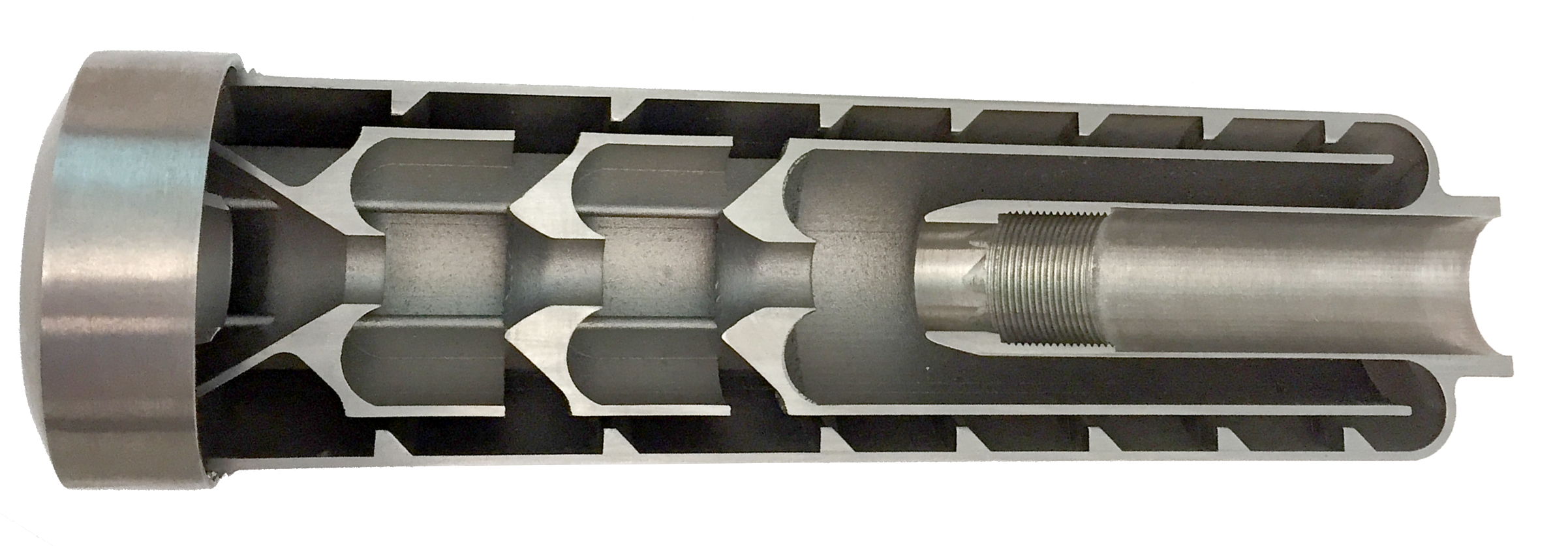The basic suppressor design for small arms has changed little over the last 100 years, with acoustic reduction resulting from internal baffles and chambers that trap, delay, and then gradually discharge propellant gases from the muzzle of the weapon. Although traditional suppressors do lower sound levels, they have serious problems that limit their widespread use. Trapping the gas in the suppressor creates blowback (gas exhaust through the open breech), which gets in the eyes, nose, and lungs of the Operator. Increased backpressure raises the firing rate and can sometimes cause the weapons to jam or be structurally damaged. At automatic weapon firing rates, trapping the hot gas overheats the suppressors. Moreover, traditional suppressors require frequent maintenance to remove trapped debris. These effects have made suppressor use the exception rather than the norm. A design that simultaneously minimizes these deleterious effects is needed to have a practical suppressor for persistent use.
The suppressor has a series of chambers for the propellant to flow through, but unlike all traditional suppressors, the chambers are open, not closed. The propellant is not trapped. It keeps moving. We manage its unimpeded flow through the suppressor. This is the key underlying technology of our suppressor design that enables all the improvements over the 100-year old traditional designs.
More technically, the internal geometry causes Mach disks to form in the propellant flow at the chamber openings. The Mach disks, acting as virtual hydrodynamic baffles, divert the flow into the chambers and minimize flow along the boreline. The resulting flow reversal reduces recoil, but still keeps the propellant moving, allowing it to cool by expansion as well as by heat transfer to the suppressor body. The flows recombine at the front of the suppressor, where an expansion nozzle further gently expands the flow, which minimizes flash. The area of the exit at the base of the nozzle ensures that the flow is not impeded, thus blowback is minimized.
This approach resolves the issues that plague traditional designs: blowback, thermal, cyclic rate, and lifetime, while still maintaining excellent sound and flash reduction. Our design simultaneously minimizes blowback, flash, noise, and temperature rise, with an elegant, easily manufacturable design, resulting in the first practical suppressor for persistent personal, training, and battlefield use.
W. Moss, A. Anderson "Computer design, 3D printing, testing, and commercialization of a revolutionary machine gun suppressor (silencer) design*", The Journal of the Acoustical Society of America 141, 3968-3968 (2017) (https://doi.org/10.1121/1.4989041)
Video: https://ipo.llnl.gov/sites/default/files/2023-05/Suppressor-LLNL-VIDEO-685057%2Baudio%2BCC.mp4
The LLNL flow-through open-chamber design simultaneously addresses every problem that has plagued suppressors since their invention over 100 years ago, including:
- Minimal blowback
- Significant flash reduction
- Reduced noise and health impacts
- Full auto use for automatic weapons including belt-fed machine guns
- Reduced temperature rise
- Minimal servicing
- Recoil reduction
- Will last the lifetime of the barrel
- Standard materials and fabrication methods
Firearms Sound Suppression (all calibers, all weapons)
Current stage of technology development: TRL 9
U.S. Patent No. 8807005 Firearm suppressor having enhanced thermal management for rapid heat dissipation dated 8/19/2014 (https://image-ppubs.uspto.gov/dirsearch-public/print/downloadPdf/8807005)
U.S. Patent No. 9052152 System and method for multi-stage bypass, low operating temperature suppressor for automatic weapons published 06/9/2015 (https://image-ppubs.uspto.gov/dirsearch-public/print/downloadPdf/9052152)


